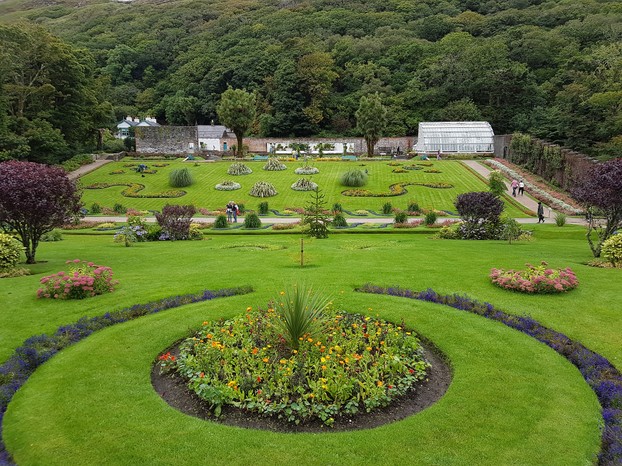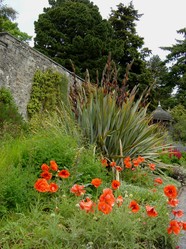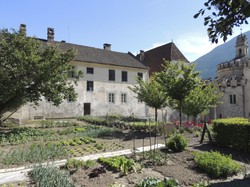Each chapter is blessed by high quality photographs of the various well-known gardens that the author has visited. His visitations were facilitated by the fact that the National Trust, the book's publisher, who commissioned the work, own many of them. We read about many of the nation's walled gardens, from famous tourist attractions such as Heligan, the lost gardens in Cornwall lovingly restored by Tim Schmidt, to less known ones, such as Blickling in Norfolk, the childhood home of Anne Boleyn, Henry the Eighth's mistress who became his queen and lost her head for her pains. Hudson wonders whether she would recognise the garden were her sad and wandering shade to return, but the archaeologist in him is aware that modern Blickling is the product of a later garden designer, so she probably would have difficulty.
We read of Chartwell in Kent, Winston Churchill's beloved garden, much of whose building work he did with his own hands. The amateur building work has been preserved in memory of the great man who was instrumental in saving civilisation from the Nazis.
The book traces the history of walled gardens from their earliest beginnings, though it focuses on British ones. The various ages of walled garden construction are analysed right from the beginning through the heyday of the walled garden in the eighteenth and nineteenth century through to their decline in the twentieth and subsequent re-emergence. Hudson provides a coherent analysis of the decline through an analysis of the social and economic history of the walled garden, which is written in his lucid style.
Another element in his work is his archaeologist's analysis of the construction and role of garden structures. We read interesting information on the erection of glasshouses and the identification of the age of the various walls. How to use clues to date and trace the development of a garden is a fascinating element in the book, which will repay return to the text and careful study. You will find this information in the section called Reading a Walled Garden. Therefore, in addition to its being a great book for leisure reading it is a useful resource for anyone studying walled gardens.






 Pilgrimage. A reviewon 06/15/2025
Pilgrimage. A reviewon 06/15/2025
 Leo the Fourteenthon 05/09/2025
Leo the Fourteenthon 05/09/2025
 The Melsonby Hoardon 03/25/2025
The Melsonby Hoardon 03/25/2025



Comments
It depends on the store. Most people by them tinned.
There indeed must be some growers in the British Isles.
The BBC Gardeners World magazine numbers among its online articles "How to grow pineapples"!
The aforementioned source offers as growing sites indoor conservatories, greenhouses or windowsills. It permits outside sojourns for home-grown pineapples only during summer months.
Would pineapples be available in the British Isles in any farmers market or grocery store or just in higher-priced specialty food stores?
I think that there are some growers, but mostly it is cheaper to import them.
Thank you for your comment below in answer to my previous observation and question.
Online sources associate pineapple introductions and plantings with King Charles II's reign.
Might one find home-grown or import pineapples at farmers markets and grocery stores in the present-day British Isles?
I cannot recall seeing the picture. But the plant would have been an import?
Thank you for your comment below on Jan. 18, 2019, in answer to my previous observations and question.
Your bringing up pineapple pits causes me to consider the painting Charles II presented with a pineapple, ca. 1675-1680. That painting either features the first pineapple grown in England or an early import.
The aforementioned theme inspired several interpretations. One version invokes a somewhat baffled, somewhat intrigued, somewhat thoughtful king looking quizzically at this edible non-English plant.
Might you have seen any version of this painting?
The garden is Felbbrigg Hall in Norfolk, East England.
Many walled gardens are completely enclosed, but in smaller properties, such as vicarages, the house and garden can be integrated, with the wall of the house constituting one of the garden walls.
The pineapple pit has low brick walls above the sides of the pit, which increase its depth. So the glass is not flush with the ground. Since the development of heated glasshouses these pineapple pits have become rare and are regarded as relics. I have only seen one, and that was at the "lost" gardens of Heligan.
The pits were deep enough for pineapples to reach their natural height
frankbeswick, Thank you for the backstory, current situation and book. Does the wall enclose the garden so that it is always separate from the rest of the property or is it possible to have a walled property within which dwelling, garden and lawn merge?
Which walled garden is on the cover?
In another direction, but related, is the glass over a pineapple pit flush with the surrounding ground? How big and how tall would pineapple fruit and stems grow?
Thanks for the explanation Frank. I will check out the other garden articles by you and your sister.
You don't sound stupid,and never do. Any garden with a wall is walled, but we traditionally use the term to denote any garden with a brick or stone wall of significant height, big enough to shield the plants from winds and land predators and to create a micro-climate. Gardens with hedges do not normally count as walled, as they are porous to wind and predators. But the difference between walls and hedges is one of degree of enclosure not of kind.
Britain is rich in walled gardens. Veronica wrote an article on one, Norton Priory.It is on Wizzley. I have given but a small sample of our nation's garden riches. Go also to my article on the Hidden Garden. Walled gardens are spread over the whole of Britain.